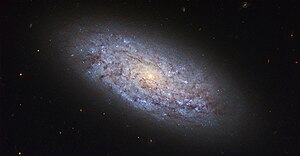Astronomy:NGC 5949
Coordinates: ![]() 15h 28m 0.67s, +64° 45′ 47.35″
15h 28m 0.67s, +64° 45′ 47.35″
| NGC 5949 | |
|---|---|
 A Hubble Space Telescope (HST) image of NGC 5949 | |
| Observation data (J2000 epoch) | |
| Constellation | Draco |
| Right ascension | 15h 28m 0.70s[1] |
| Declination | 64° 45′ 48.0″[1] |
| Redshift | 0.001414±0.000073[1] |
| Distance | 44 Mly (13.49 Mpc)[1] |
| Apparent magnitude (V) | 12.1 |
| Characteristics | |
| Type | SA(r)bc[citation needed] |
| Size | 30,000 ly (diameter)[citation needed] |
| Apparent size (V) | 1.9 x .89[citation needed] |
| Notable features | Bright hot blue stars make up most of the galaxy |
| Other designations | |
| LEDA 55165, SDSS J152800.67+644547.4, Z 319-16, IRAS F15273+6456, 2MASX J15280067+6445473, TC 847, Z 1527.4+6455, IRAS 15273+6456, MCG+11-19-008, UGC 9866, K73 682, PSCz Q15273+6456, UZC J152800.7+644547 | |
NGC 5949 is a dwarf spiral galaxy located around 44 million light-years away in the constellation Draco.[2] NGC 5949 was discovered in 1801 by William Herschel, and it is 30,000 light-years across. NGC 5949 is not known to have an Active galactic nucleus, and it is not known for much star-formation.
Characteristics
With a mass of about a hundredth that of the Milky Way, NGC 5949 is a relatively bulky example of a dwarf galaxy.[2] Its classification as a dwarf is due to its relatively small number of constituent stars, but the galaxy’s loosely-bound spiral arms also place it in the category of barred spirals. This structure is just visible in the Hubble Space Telescope (HST) image,[3] which shows the galaxy as a bright yet ill-defined pinwheel. Despite its small proportions, NGC 5949’s proximity has meant that its light can be picked up by fairly small telescopes, as discovered by William Herschel.[2]
Astronomers have run into several cosmological quandaries when it comes to dwarf galaxies like NGC 5949.[3] For example, the distribution of dark matter[3] within dwarfs is quite puzzling (the “cuspy halo” problem), and our simulations of the Universe predict that there should be many more dwarf galaxies than we see around us (the “missing satellites” problem).[3]
References
- ↑ 1.0 1.1 1.2 1.3 "NGC 5949". http://simbad.u-strasbg.fr/simbad/sim-basic?Ident=NGC+5949.
- ↑ 2.0 2.1 2.2 "The New General Catalogue (NGC) in Draco". https://in-the-sky.org/data/catalogue.php?cat=NGC&const=35.
- ↑ 3.0 3.1 3.2 3.3 "NGC 5949 - Galaxy - SKY-MAP". http://www.wikisky.org/starview?object_type=2&object_id=2923.
External links
- "NGC 5949". SIMBAD. Centre de données astronomiques de Strasbourg. http://simbad.u-strasbg.fr/simbad/sim-basic?Ident=NGC+5949.
 |

